Comparing Battery Brands Experiment Plus Why is Calibration Important?
Comparing Battery Brands Experiment Plus Why is Calibration Important? |
Does the brand of battery mean your logger will run for longer?You need to log for a period of time and you are sick of batteries running out after a few hours. So, which brand of battery will give you the best lifetime? Read on to find out! Do you ever wonder why calibration is so important and what it is?Well this month we will be covering off some basics regarding calibration, along with the differences in some of the terms used when it comes to calibration. | |
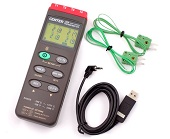 Does the brand/type of battery you use extend the logging life of your logger?For this month’s experiment we are going to investigate whether a certain brand/type of battery performs better when logging over time. To do this 4 identical temperature loggers will be set up to log at the same interval, each will have a 9V battery fitted, 3 batteries will be alkaline and 1 will be Lithium to determine if there is a significant difference. The voltages of each of the 9V batteries will then be logged over the same time period using a 4 channel analogue input logger. This will allow us to view how the voltage drops over time until the loggers stop logging. So which battery will last the longest? | |
Equipment
Method 1) The CABLE-ADAP10 was fitted to each of the 4 batteries. The white lead was connected to the positive terminal and the black lead was connected to the negative terminal. The terminal connection was then connected to the C309. 2) Each of the C309 loggers were connected to the PC and the time was set along with the sampling interval. The sampling rate was set at a 1 minute interval. 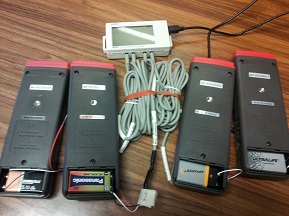 Figure 1: The loggers setup ready to begin the battle 3) The was then connected to the PC and set to start at a certain time and date at a 1 minute sampling interval to align with the C309's. This was 15 minutes after the current time to allow us to set all the required components up. It was also set to recognise the CABLE-ADAP10 to allow us to log the voltage. 4) As the countdown timer on the UX120-006 reached zero all of the C309 loggers were started simultaneously. 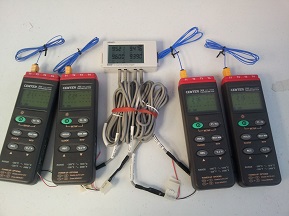 Figure 2: The loggers started and undergoing the battle 5) The loggers were then left in place until the alkaline batteries failed. The data was then downloaded and analysed to determine the winner. The results can be viewed in the section below. Results The results were all very close and remarkably consistent between the three methods. All steaks came out medium rare, although the finger test and the timer steaks came out a little bit more cooked than the thermometer method. It is worth mentioning that our steaks were about 2cm thick and for a thicker steak the results may have been different if we had used the timer method. We also found that the finger method was quite subjective, and it was hard to tell exactly when it was as firm as our thumb. In regards to the thermometer method, the key was to make sure that the thermometer was well inserted and in the thickest part of the steak and clear of any fat or gristle. 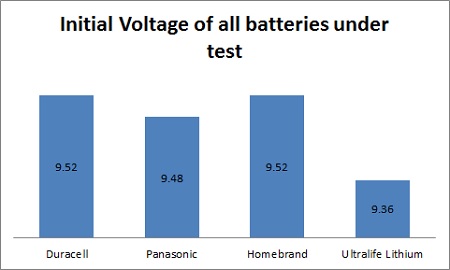 Figure 3: Initial voltages of all batteries under test. Interestingly all batteries under test started at almost identical initial voltages. 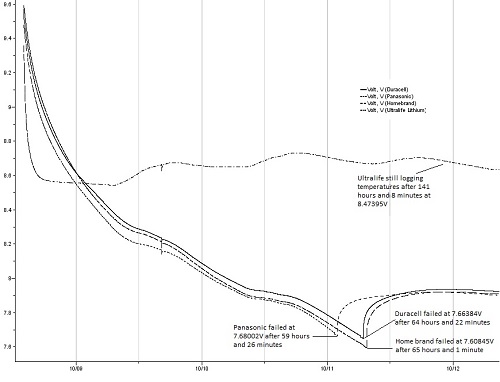 Figure 4: Changes in voltage over time and where each battery failed to continue temperature logging for the C309's. Discussion and Conclusion The results show that under this test there is very little difference in performance between the alkaline batteries under investigation. All of the alkaline batteries lasted between 59 hours and 26 minutes (Panasonic) up to 65 hours and 1 minute (Homebrand Battery) and therefore there is not a significant difference for the time period they have lasted for. As such you may be better off buying cheaper, less expensive batteries, or getting Duracells when they are on sale because as our tests show there is no measurable difference when it comes to lifespan between the batteries. The very notable exception is the Ultralife Lithium Battery. Whilst this battery had the steepest drop in voltage initially, when it flattened out to approximately 8.5V it just kept on going and is still currently logging. This indicates that the Lithium battery does far outweigh lifespan when compared with Alkalines. In saying this Lithium batteries are significantly more expensive than Alkalines and as such it may be more cost effective to replace batteries at a more frequent interval. However, if you need to perform an investigation over the course of a number of days and cannot afford to replace batteries then using the Lithium option will be of great benefit. Have your say! How long do you think the
Ultralife Lithium Battery will keep the C309 logging for?
| |
 Calibrations Explained! What are they and what should you know about them?What is calibration and why is it important?Put simply, calibration is a measurement comparison between an instrument or device of known correctness (the standard or calibrator) and a second device (the unit under test). By comparing the measurement of the unit under test to the standard, it is possible to determine the accuracy of the unit under test. A calibrated instrument can then be used to provide more accurate results and the user can be more confident in the results given by the instrument. Adjustment vs Offset?Through the calibration process some pieces of instrumentation have the ability to be adjusted following calibration so that they more closely match the standard or calibrator. For example, the ECTEMP6-01 can be adjusted after calibration, so if it was tested at 25.0C and it was reading 25.1C it could be adjusted down to 25.0C so it would then read correctly. Some meters however do not have an adjustment feature, and for these meters an offset must be applied. For example, the IC7310 cannot be adjusted, so if it was calibrated at 25.0C and it was reading 25.1C then you would need to apply an offset of -0.1C to any readings you took to get the most accurate measurement. Calibration certificates will list the offset that you need to apply on units that cannot be adjusted. How frequently should I calibrate my instrument?As a general rule, each piece of instrumentation you have should be calibrated in a calibration laboratory at least once a year. For items like gas detectors, you may need to calibrate 6 monthly. You may also find that there are certain requirements related to your industry that may require calibration at a higher frequency NATA vs NATA Traceable?For calibrations you can choose between a NATA calibration and a traceable calibration. NATA calibrations are performed in laboratories that are independently audited by NATA and meet the requirements as set out in the international standard ISO/IEC 17025. A traceable calibration is performed in a laboratory that is not independently audited by NATA and will not necessarily meet the requirements set out in ISO/IEC 17025, however there is traceability to NATA as the equipment used is NATA calibrated. |
